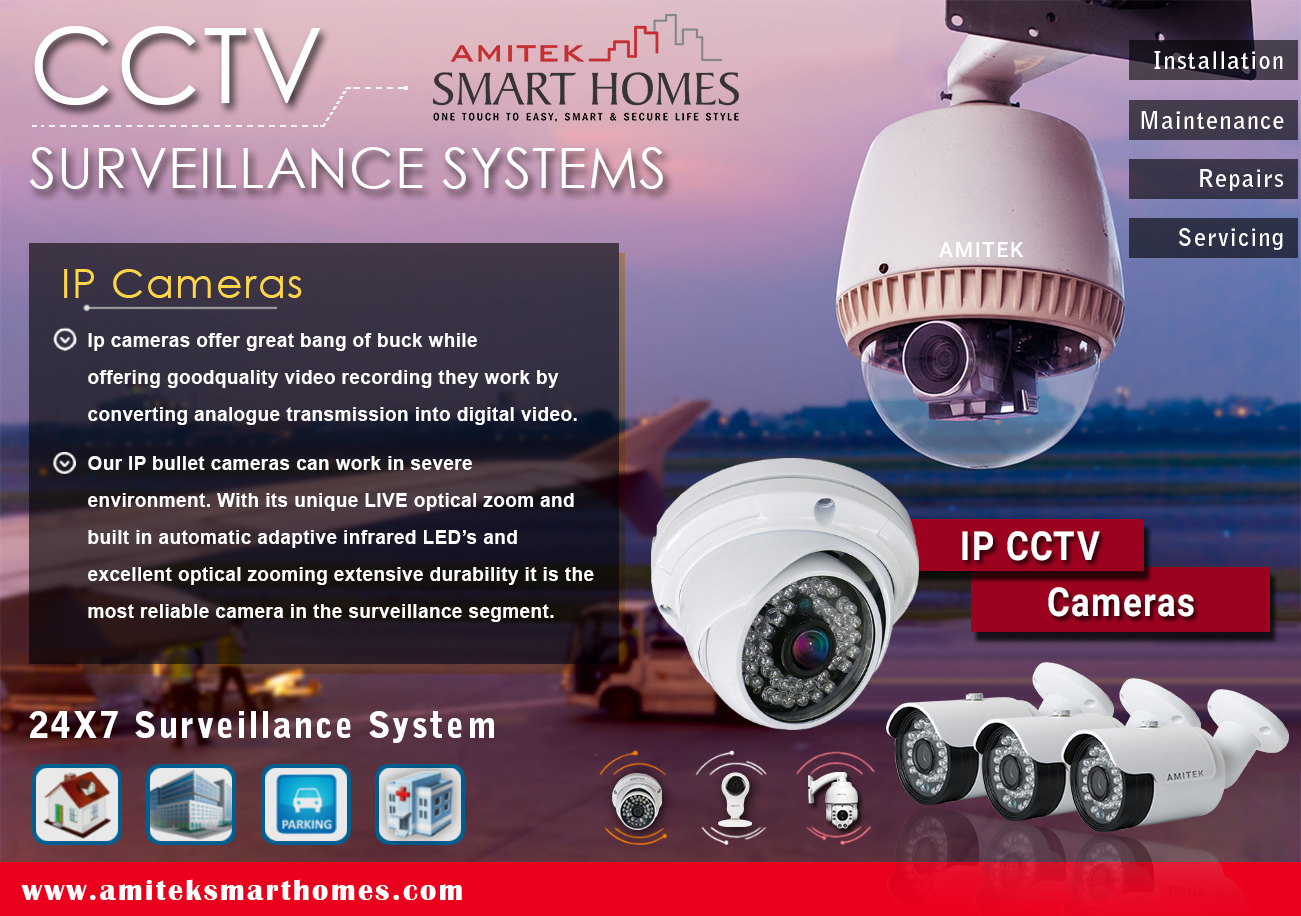AMITEK IP Based CCTV CAMERA SOLUTION: Technology Moving from Analog to IP Technology
Posted on August 28, 2018 at 12:45 PM UTC
Amitek IP Based CCTV Cameras
There is an immense variety of options available to you. Closed-circuit television systems (CCTV) are popular. Operating via a closed network, these systems can operate continuously or only at specific times at your request. CCTV offers benefits not only to security but also to enhancing the efficiency of your business operations.
Internet Protocol (IP) camera mainly is composed of a lens, an image sensor (typically CMOS image sensor) and an image processor, and a H.264/H. 265 video compression SoC (System on Chip) and an Ethernet chip that allow camera to connect to network for video broadcasting(ONVIF PROTOCOL).
When light passes through the lens to the sensor, the image sensor will convert it to digital signals then processed by a built-in image signal processor (ISP). Instantly, the signal will be compressed with H.264 format by a multimedia SoC to minimize the file size for optimal transmission. Finally, the video images are sent through the network to back-end device for viewing or recording.
There are a number of reasons for this, ranging from budgetary to technological. Let’s look at the top four of them:
- Image Resolution – All analog video cameras use the NTSC analog video standard, which was created in the 1950s. No matter what the camera’s manufacturer claims the image quality is, it is still being transmitted and recorded using this standard. It is an absolute cap on image resolution that you can’t get around. On the other hand, IP cameras come in a broad range of resolutions (measured in megapixels, or MPs) from which to choose depending on your specific requirements. For example, a 1.3 MP IP camera (generally the lowest resolution camera on the market) has almost 4 times the resolution of an analog camera. With this added resolution, faces become clearer, license plates become easier to read and larger areas can be covered by a single camera.
- Scalability – Generally, analog cameras run a coax cable transmitting the video to a VHS recorder, which records straight to video tape or a DVR (Digital Video Recorder), which turns the analog signal into a digital signal for storage and review. The problem with this is that the VHS or DVR has a finite number of ports that cameras can be plugged into. Once you max out that number of ports, you would need to either buy a new VHS or DVR with more ports or a second, separate machine to run the additional cameras. IP video networks have the clear advantage when it comes to adding new video cameras.
First, since IP cameras connect to the IT network, there is no limit to the number of cameras that can be connected. Second, the need to run a cable from the camera to the DVR is eliminated – you only need to run a cable to the nearest network switch. Third, in IP-based systems the video is recorded using NVRs (Network Video Recorders), which use multiple hard drives and often employ a backup technique know as RAID (Redundant Array of Independent Disks) to disperse the data across multiples hard drives for data safety and efficiency. Fourth, since the data is being transmitted digitally, it can be transmitted across the internet, allowing for multiple locations to utilize the same NVR, meaning that a new video system does not need to be set up at each site, allowing for scaling beyond your existing facility.
- Ease of Installation – Many find it hard to believe but at this point IP video security systems are actually quite easy to install. Today, most IP cameras are actually plug-and-play, the same way your computer’s webcams are. In addition, the cabling is easier as well. With an analog camera, which has a single cable that can only transmit its video signal, it will also require a separate power cable and, if you want added functionality such as PTZ (Pan, Tilt, Zoom) controls for the camera you’ll need another cable for that. However, IP cameras use a single cable that can be used for everything. Using PoE (Power over Ethernet), IP cameras can be powered through the same cable that transmits the video signal and any PTZ commands. Finally, as mentioned above, since IP cameras run on the network, you don’t have to run the cable all the way back to the DVR. Instead, you only need to run it to the nearest network switch.
As the technology continues to improve, we see the cost of IP cameras dropping as well. As the cost of IP cameras becomes more competitive with analog cameras, combined with the above-mentioned benefits of improved image resolution, scalability, ease of installation and the ability to apply video analytics, now is the time to move your video security system from analog to IP. That’s how the world is “Transitioning from Analog to IP Video”.
#cctvsolutioninIndia#cctvsolutioninDelhi #cctvsolutioninMumbai #cctvsolutioningujarat#surveillancesolutioninIndia #hsurveillancesolutioninDelhi #surveillancesolutionsinMumbai #surveillancesolutioninGujarat #ipbasedsurveillancesolution #ipbasedsurveillancesolutioninrajasthan #ipbasedsurveillancesolutionindelhi #ipbasedcctvsolutioninmumbai #ipbasedcctvsolutioningujarat#surveillancesolutioninIndia #surveillancesolutioninDelhi #surveillancesolutioninMumbai #surveillancesolutioninGujarat #surveillancesolutioninRajasthan